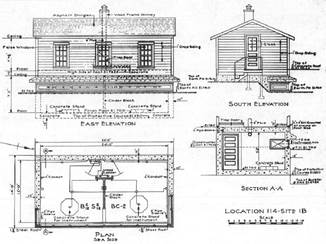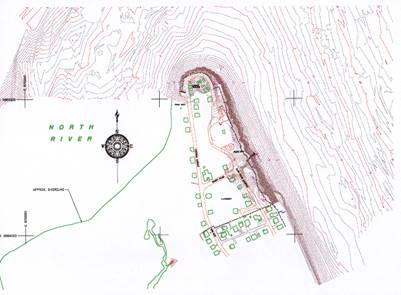|
The US government created a life-saving station at Fourth Cliff in 1880. Fourth Cliff became a Navy Radio Compass Station after World War I. A US Army Coastal Artillery Gun Site was built during War II by the government. The military history of Fourth Cliff states, “The concrete work was completed by local construction companies and when completed became one of the most unique and deadly Coastal Fortifications in New England.” The “bunker” and observation tower are still here (currently not open to visitors at this time) but the guns are gone. From the ocean the barrack area was created to look like cottages on a cliff. In reality it was a hidden military base. A radar unit was positioned on Holly Hill (across the South River in Marshfield) to guide the six-inch guns. The gun battery was concealed by a mock road and shrubbery. For the duration of the war, the guns were only fired once – to test them. The observation tower was built of reinforced concrete and camouflaged with a wooden shell and false front. |
|---|

|
As a result of The Great Storm of 1898, Fourth Cliff became detached from Scituate when a new mouth (The New Inlet) for the North River was created. Since 1898 the only access to Fourth Cliff is through Marshfield, MA (an adjoining town to Scituate). From 1640 to 1872, the North River was famous for shipbuilding and shipyards. A total of 1,025 ships were constructed from as many as 23 shipyards along the North River. The waterway surrounding Fourth Cliff is considered one of the most dangerous inlets on the Atlantic coast. The swift flowing North River has a reputation for causing many shipwrecks. Fourth Cliff was a popular summer vacation spot for residents of Boston during the 1800’s.
|
|---|

|
The first military presence at Fourth Cliff began in 1942 with the construction of concrete watchtowers, command bunkers and gun emplacements. Fourth Cliff is one of many built along the New England coast to provide early warning of enemy attack. It has been an army coastal artillery station and part of the WWII Boston Harbor coastal defenses. Construction of the battery was completed on October 1, 1943 and turned over to the Army more than a year later. Battery 206, located at Fourth Cliff, barely made it into service before the war ended. Battery 206 had two 6-inch Model T2 guns mounted on M4-BC carriages, and its construction cost a total of $334,000. Its two guns were mounted with trunnion elevation about 60 feet above sea level. The original motors and generators that supplied power for the guns are still within the equipment bunkers, which are secured behind heavy steel doors. The ammunition ready alcoves serving both guns, however, are easily visible. Battery 206 contained an unusual feature a concrete fire control bunker, with a small wooden shed-like structure built on its roof as camouflage.
|
|---|

|
Today the magazine and battery are very much as it was when it was built. The platform for Gun 1 has been covered with a wooden pavilion which serves as a picnic area for service members. Gun 2, on the north side of the magazine, has been converted for use as a recreation vehicle (RV) camping sites. There were two fire control towers at Fourth Cliff, which could be reached by ladder from the magazines below. It was designed to hold two observation stations: a Battery Commander's station for Battery 206 and a BES for the 16-inch guns at Fort Dawes, these have survived. The 5-story tower is located at the northern tip of the peninsula. This tower was completed on April 2, 1943 and originally had a 31 foot-square wooden barracks building attached to its western side, but all that remains of these crew quarters is the concrete foundation pad.
|
|---|

|
In its top story the tower had a base end station with an instrument height above sea level of 83 feet (BES #3) for nearby Battery 208. The fourth story, at 75 feet housed BES #2 for Battery Long, the 16-inch guns in Hull, and the third story was a spare. The other fire control tower at Fourth Cliff was the "tower-in-a-house", near the southern end of the reservation. This 3-story tower, completed on November 6, 1943, camouflaged to resemble a shorefront cottage, contained several observation stations.On the third floor, equipped with a DPF instrument, was BES #1 (B1/S1) for the 16-inch guns of Battery Murphy at East Point in Nahant. Beneath this, the second floor contained two stations, each with a DPF instrument. On the right (looking seaward) was BES #1 for the 6-inch guns of Battery Jewell on Outer Brewster Island. On the left was the OP for the G-1 command (which controlled the southern group of guns protecting the harbor).
|
|---|
|
The command post (CP) for the G-1 command occupied the entire first floor of the tower. The tower itself was accessed through a door from the 16-man rectangular (20 x 32 ft.) wooden barracks building that is attached to the west (inland) side of the tower. The antiaircraft (AAIS) spotting station (OP-3 in the system, which started at Halibut Point in the north and ran down to Gurnet Point in the south) occupied the cupola atop the 3-story tower, reached by climbing a ladder from the third story and then popping open a hatch to the roof. Fourth Cliff is one of a series of cliffs located in Scituate, MA. It is on a peninsula with the Atlantic Ocean on the east and the North and South Rivers to the west. Before 1898, Fourth Cliff was connected to Third Cliff. As a result of The Great Storm of 1898, Fourth Cliff became detached from Scituate when a new mouth for the North River was created.
|
|---|
|
According to the historical records, “The site was extremely important for the Southern Strategic Defense of Boston Harbor. Sixty inch searchlights were mounted along the cliff, machine gun nests were established and manned, anti-aircraft weapons were emplaced and beach patrols were created by elements of the Army garrison in conjunction with the Coast Guard and canine patrols.” After World War II the armament was removed and a caretaker was hired. Fourth Cliff was named an Air Force Field Station in 1948. During that year unspecified laboratory experiments were conducted by the military. In the 1950’s two giant radio towers were constructed to test low-frequency transmissions to communicate with submarines. The towers were dismantled in 1966 and the area slowly transformed to recreational use. Today, Fourth Cliff is operated and maintained by Hanscom Air Force Base located in Bedford, MA.
|
|---|
|
|
|---|
| Fourth Cliff Home | Fourth Cliff's History | Fourth Cliff Today | Fourth Cliff's Future |
|---|
